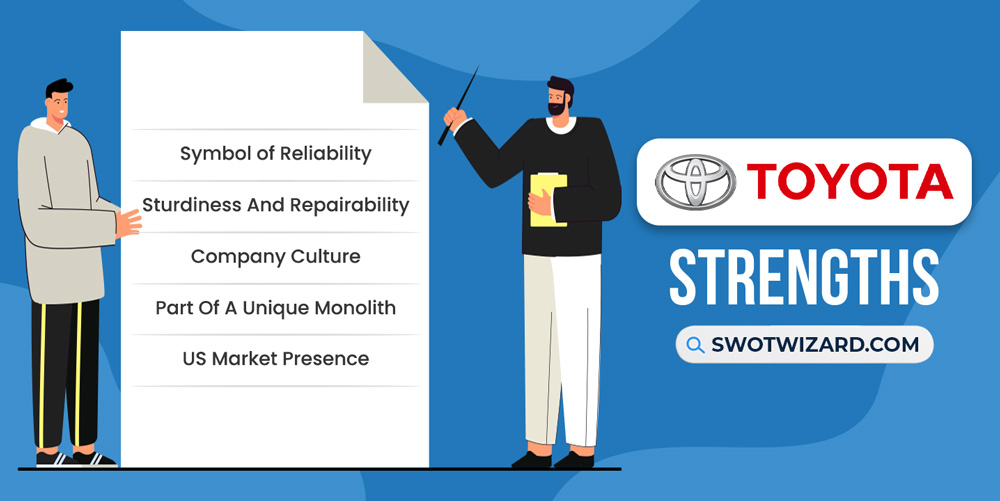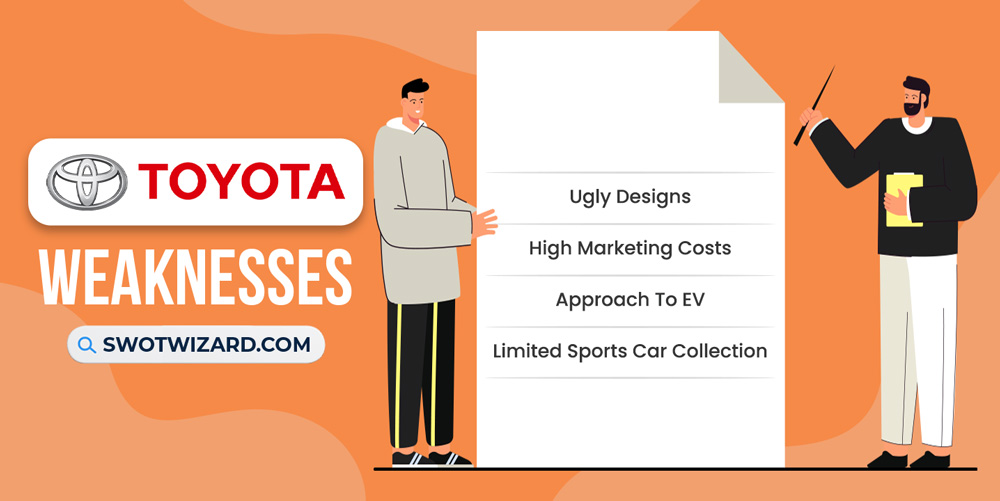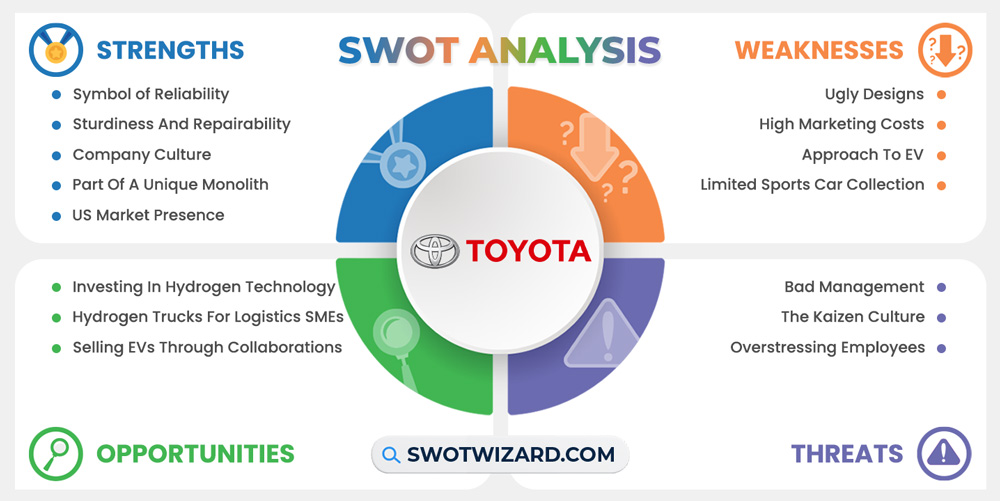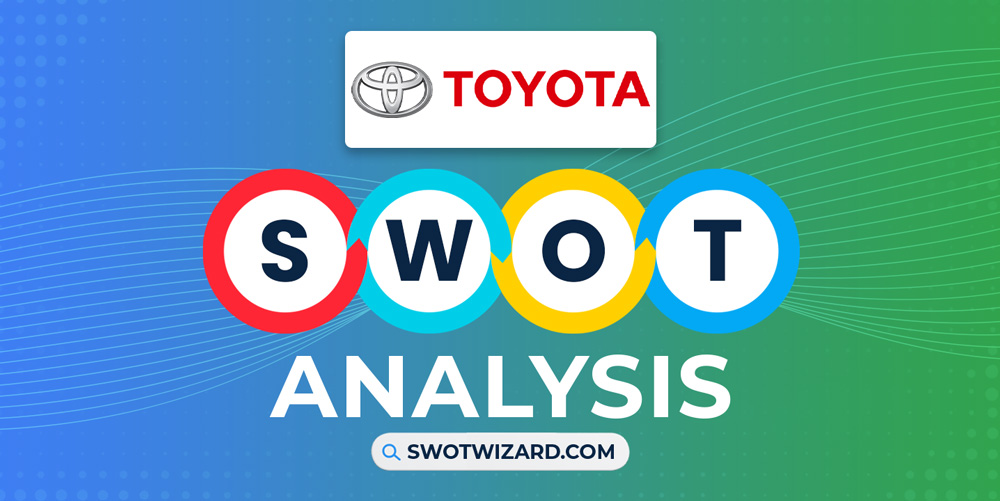If you have a car that is years old and driven daily but still runs smoothly without complaint, odds are you have a Toyota. The company is an automotive giant built on consistency, hard work, and principles, with the record of the highest-sold car model under its belt. For its steadfast market presence and success, it deserves a look under the hood through the Toyota SWOT analysis.
Toyota: Company Overview
| Company | Toyota Motor Corporation |
| Industry | Automobile |
| Founded | 28 August, 1937 |
| Founder | Kiichiro Toyoda |
| CEO | Koji Sato |
| Headquarter | Toyota City, Aichi, Japan |
| No. of Employees | 366,283+ |
| Annual Revenue | $256.7 billion (FY 2021) |
| Website | toyota.com |
In 1933, Toyota Motor Corporation was opened as a division within Toyoda Automatic Loom Works. It released its 1st car, the Model AA in 1936 but stalled passenger car production till 1947 due to World War II. The company tried and failed to enter the US market in 1958 but saw the commercial success of the Corona model in 1965 in the US.
In 2023, Toyota is a market leader in the automotive industry, with the 51st spot in the list of top companies by market cap. The company is headquartered in Toyota City, Aichi, Japan, and had 372,817 employees worldwide in 2022. In the same year, Toyota generated $267.02 billion in TTM revenue.
Product & Services of Toyota
Automobile | Materials Handling Equipment | Textile Machinery | Financial Services | Housing | Marine Services | Agribio Services
Toyota Competitors
Mercedes Benz | BMW | Ford | Honda | Nissan | Audi | Tesla | Maruti Suzuki | Volkswagen | Porsche | Hyundai
Did You Know?
By 1950 Toyota was dying due to the aftermath of World War II and the Forgotten War, and the US government jump-started the brand by ordering 5,000 trucks from the company.
Strengths – Toyota SWOT Analysis

Symbol of Reliability: Toyota is a household name that is synonymous with reliability. In 2022, Toyota sold 1.12 million units of the Corolla model, which is the most sold car on Earth. The Corolla model has been in production for 50 years and has been consistently improving, much like many other models Corolla manufactures. No matter how boring, stale, or simple Toyota’s popular models may appear, they have a long history as reliable transportation, and customers trust in that image.
Sturdiness And Repairability: Toyota cars are tough and hardly ever break. And when they do, they only need some elbow grease to get going again. In a survey from 2016, Toyota Prius C and Prius were found to be the sturdiest sedans, the Sienna was the sturdiest minivan, Rav4 and 4Runner were the toughest SUVs, and Tundra was the sturdiest Pickup truck. When it comes to DIY repairs, Toyota Corolla, Tacoma, and 4Runner are easy to find parts for and have many online guides for diagnosis and repair. If a Toyota must be repaired, the cost of an average engine repair can be as low as $83.
Company Culture: As a Japanese company, Toyota has the country’s culture of hard work, dedication, passion, loyalty, and innovation running in its blood. From the highest level of management down to the employees working on the assembly line, every member of staff constantly strives to achieve the highest performance possible. To achieve full efficiency and perfection, Toyota trains its staff extensively to create teams of loyal and perfectionist engineers and technicians. Toyota constantly pushes the boundary for innovation and has come up with assistant robots, Automated Highway Driver Assist, wireless charging for EVs, super compact cars, and more within 2014.
Part Of A Unique Monolith: Toyota is a company under The Toyota Group, which is known to be 1 of the 8 keiretsu, or gigantic conglomerates of Japan. The Toyota Group is vertically integrated, with 16 major companies that manufacture products that aid the production of its primary products. For example, Aichi Steel produces automotive steel, JTEKT, and Toyota Boshoku produces auto parts, Toyota Industries, Aisin, DENSO, and Toyoda Gosei are all automotive manufacturing components that directly support Toyota’s car production. Toyota has an ecosystem built for its car production, making it highly resistant to external change drivers and resourcing issues.
US Market Presence: Toyota is an internationally dominant car company, selling well over 2 million cars consecutively for 6 years till 2019. Even in the middle of the pandemic in 2021, the company sold 851,241 cars globally and produced 801,145 of those units. In 2022, Toyota sold 1,755,552 cars just in the US market, and within March 2023, it sold 390,819 cars. Only Ford managed to outsell Toyota by 8,715 cars in 2022, with Chevrolet coming in 3rd place with 242,677 fewer cars sold from Toyota.
Weaknesses – Toyota SWOT Analysis

Ugly Designs: Just like it is celebrated for its reliability, Toyota is criticized for its ugly car designs. Toyota’s cars are always designed with practicality and reliability in mind, and aesthetics is ignored as it’s not considered to be functional. Although Toyota 2000 GT is proof that the company can design a beautiful sports car, most of its popular models are considered uninspiring. It has gotten to a point where customers now unanimously list off Toyota models that they consider ugly.
High Marketing Costs: Toyota’s marketing costs have increased year by year, with billions of dollars spent only in the US market. Toyota spent over $2.09 billion in both 2013 and 2014 for marketing in the US, which was its highest marketing expenditure in history. In 2021 the company spent $1.57 billion, which was 4th highest among automakers competing in the US. Toyota’s insistence upon traditional marketing keeps increasing its marketing expenditure, but the company has not changed much in response.
Approach To EV: Toyota’s collection of electric cars was already limited to bZ4X and RAV4 EV, and the company discontinued RAV4 EV in 2014. The company has been lagging in EV production in a market where EVs have begun to take over. Toyota’s pursuit of perfection and Carbon neutrality has made the company cancel some of its 30 EV projects announced in December 2022 and restructure its EV strategy. Toyota’s new CEO Koji Sato claims to plan for the long run, making the company’s entry into the EV market painfully slow.
Limited Sports Car Collection: Toyota is also limited in its sports car collection, offering almost nothing in the genre. It took the company till 2020 to bring back its legendary Supra, even if the 2023 version comes with a disappointingly low 382 hp and 368 lb-ft of torque. Then, instead of introducing new sports cars or revamping older lines, Toyota instead chose to make sportier versions of the Toyota 86 and Corolla. The company fails to understand the marketing value and performance showcase a sports car provides and subsequently fails to attract a larger customer base.
Opportunities – Toyota SWOT Analysis

Investing In Hydrogen Technology: Toyota built the Mirai in 2016 as a proof of concept for hydrogen cars, and now in 2023, it has nearly perfected the design. However, hydrogen cars are still limited in California. Toyota can lead the charge in the industry and aggressively invest in manufacturing Hydrogen fuel to create a Blue Ocean advantage for itself.
Hydrogen Trucks For Logistics SMEs: To further secure ground for Hydrogen fuel profitably, Toyota can offer Logistics based SMEs in California, and adjacent areas B2B deals for its Hydrogen trucks. The technology allows refueling faster than any EV truck charging could, and it only produces water as a byproduct. Toyota can market the technology and its benefits through this tactic.
Selling EVs Through Collaborations: Toyota can expedite its EV research and manufacturing by collaborating with other automakers. It can either produce automotive parts for other companies or borrow their electric motors to power its EV models. This decision would allow the company to better understand how to manage EV manufacturing without taking the associated risks.
Threats – Toyota SWOT Analysis

Bad Management: While Toyota is known as a symbol of reliability, it dropped the ball in 2009. The company had to recall over 10 million cars due to a myriad of technical issues, which may have led to 52 deaths in 43 crashes since 2000 in the US. A lack of internal change in centralized and hierarchical management led to this issue, which has not changed to date. If Toyota doesn’t let go of tradition and restructure its management, it may face an even larger crisis in the future.
The Kaizen Culture: Being a Japanese company, Toyota practices the Kaizen culture. However, the constant push for improvement takes away its ability to create new products and embrace change. If Toyota bullheadedly continues to push for improvement, it can experience operational failure when its departments fail to work in unison.
Overstressing Employees: Another issue with Toyota as a Japanese company is that it embraces the idea of working its employees to death. In 2010, a Toyota employee committed suicide due to being harassed and overworked by his supervisors. While Toyota promised a change, it has not let up on its push for employee performance.
[Bonus Infographic] SWOT Analysis of Toyota

Recommendations for Toyota
Toyota can consider these changes to improve its sales.
- Toyota should bring back its sports car models.
- It can redesign the Corolla to look more modern.
- Toyota can sell its Hydrogen trucks and fueling service as a package.
- It can focus on selling cheaper models in Asian countries.
- Toyota should offer custom rim options for its GR models.
Frequently Asked Questions (FAQs)
What is Toyota’s marketing strategy?
Toyota markets itself differently in each market but identifies itself as unique as a core strategy.
What is Toyota’s slogan?
Let’s go places.
Final Words on Toyota SWOT Analysis
Toyota is a company backed by a resilient ecosystem of supporting companies and hard-working staff, with an image unmatched in the automobile market. All it needs to do is push for innovation and aesthetics, and it can establish itself as the undisputed market leader.
References
- Wikipedia contributors. (n.d.). Toyota. Wikipedia.
- 6 innovative projects from Toyota Motor Corporation. (2014, June 4). Toyota UK Magazine.
- Cain, T. (n.d.). Toyota Sales Figures – US Market. GoodCarBadCar.net.
- Prosser, R. (2020, March 18). The Real Reason Why Toyota Makes The Most Reliable Cars. HotCars.
- Shirouzu, N. (2022, October 25). Exclusive: Toyota scrambles for EV reboot with eye on Tesla. Reuters.
- The Editors of Encyclopaedia Britannica. (2023, March 3). Toyota Motor Corporation. Encyclopedia Britannica.
- Veron, M. (2020, August 31). 10 Facts No One Knows About Toyota. HotCars.




